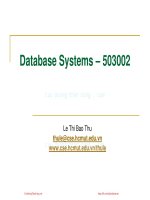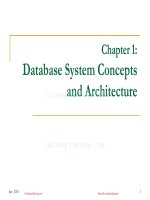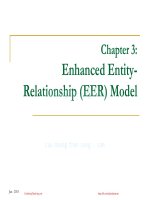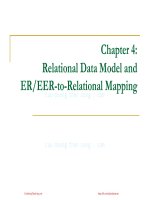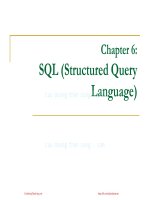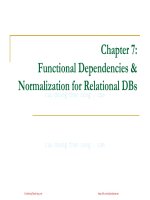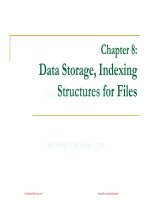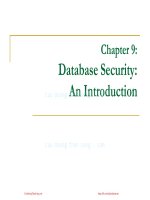cơ sở dữ liệu lê thị bảo thu chương ter 08 data storage indexing structures for files sinhvienzone com
Bạn đang xem bản rút gọn của tài liệu. Xem và tải ngay bản đầy đủ của tài liệu tại đây (2.26 MB, 92 trang )
Chapter 8:
Data Storage, Indexing
Structures for Files
CuuDuongThanCong.com
/>
Overview of Database Design Process
Jan - 2015
CuuDuongThanCong.com
/>
2
Contents
1
Data Storage
1.1
Disk Storage Devices
1.2
Files of Records
1.3
Operations on Files
1.4
Unordered Files & Ordered Files & Hashed Files
1.5
RAID Technology
2
Indexing Structures for Files
2.1
Types of Single-level Ordered Indexes
2.2
Multilevel Indexes
2.3
Dynamic Multilevel Indexes Using B-Trees and B+-Trees
2.4
Indexes in Oracle
Jan - 2015
CuuDuongThanCong.com
/>
3
Contents
1
Data Storage
1.1
Disk Storage Devices
1.2
Files of Records
1.3
Operations on Files
1.4
Unordered Files & Ordered Files & Hashed Files
1.5
RAID Technology
2
Indexing Structures for Files
2.1
Types of Single-level Ordered Indexes
2.2
Multilevel Indexes
2.3
Dynamic Multilevel Indexes Using B-Trees and B+-Trees
2.4
Indexes in Oracle
Jan - 2015
CuuDuongThanCong.com
/>
4
Disk Storage Devices
Preferred secondary storage device for high
storage capacity and low cost.
Data stored as magnetized areas on
magnetic disk surfaces.
A disk pack contains several magnetic disks
connected to a rotating spindle.
Disks are divided into concentric circular
tracks on each disk surface .
Jan - 2015
Track capacities vary typically from 4 to 50
Kbytes.
CuuDuongThanCong.com
/>
5
Disk Storage Devices (cont.)
Jan - 2015
CuuDuongThanCong.com
/>
6
Disk Storage Devices (cont.)
Track
Sector
Spindle
Jan - 2015
CuuDuongThanCong.com
/>
7
Disk Storage Devices (cont.)
A track is divided into smaller blocks or
sectors.
because a track usually contains a large amount
of information .
A track is divided into blocks.
The block size B is fixed for each system.
Jan - 2015
Typical block sizes range from B=512 bytes to
B=4096 bytes.
Whole blocks are transferred between disk and
main memory for processing.
CuuDuongThanCong.com
/>
8
Disk Storage Devices (cont.)
A read-write head moves to the track that contains the
block to be transferred.
A physical disk block (hardware) address consists of:
Disk rotation moves the block under the read-write head for
reading or writing.
a cylinder number (imaginary collection of tracks of same
radius from all recorded surfaces)
the track number or surface number (within the cylinder)
and block number (within track).
Reading or writing a disk block is time consuming
because of the seek time s and rotational delay (latency)
rd.
Double buffering can be used to speed up the transfer of
contiguous disk blocks.
Jan - 2015
CuuDuongThanCong.com
/>
9
Disk storage devices (cont.)
Jan - 2015
CuuDuongThanCong.com
/>
10
Contents
1
Data Storage
1.1
Disk Storage Devices
1.2
Files of Records
1.3
Operations on Files
1.4
Unordered Files & Ordered Files & Hashed Files
1.5
RAID Technology
2
Indexing Structures for Files
2.1
Types of Single-level Ordered Indexes
2.2
Multilevel Indexes
2.3
Dynamic Multilevel Indexes Using B-Trees and B+-Trees
2.4
Indexes in Oracle
Jan - 2015
CuuDuongThanCong.com
/>
11
Records
Fixed and variable length records.
Records contain fields which have values of a
particular type.
E.g., amount, date, time, age.
Fields themselves may be fixed length or
variable length.
Variable length fields can be mixed into one
record:
Jan - 2015
Separator characters or length fields are needed
so that the record can be “parsed”.
CuuDuongThanCong.com
/>
12
Records (cont.)
Jan - 2015
CuuDuongThanCong.com
/>
13
Blocking
Blocking: refers to storing a number of
records in one block on the disk.
Blocking factor (bfr): refers to the number
of records per block.
There may be empty space in a block if an
integral number of records do not fit in one
block.
Spanned Records: refer to records that
exceed the size of one or more blocks and
hence span a number of blocks.
Jan - 2015
CuuDuongThanCong.com
/>
14
Blocking (cont.)
Jan - 2015
CuuDuongThanCong.com
/>
15
Files of Records
A file is a sequence of records, where each record is
a collection of data values (or data items).
A file descriptor (or file header) includes information
that describes the file, such as the field names and
their data types, and the addresses of the file blocks
on disk.
Records are stored on disk blocks.
The blocking factor bfr for a file is the (average)
number of file records stored in a disk block.
A file can have fixed-length records or variablelength records.
Jan - 2015
CuuDuongThanCong.com
/>
16
Files of Records (cont.)
File records can be unspanned or spanned:
Unspanned: no record can span two blocks
Spanned: a record can be stored in more than one block
The physical disk blocks that are allocated to hold the
records of a file can be contiguous, linked, or indexed.
In a file of fixed-length records, all records have the
same format. Usually, unspanned blocking is used with
such files.
Files of variable-length records require additional
information to be stored in each record, such as
separator characters and field types.
Jan - 2015
Usually spanned blocking is used with such files.
CuuDuongThanCong.com
/>
17
Contents
1
Data Storage
1.1
Disk Storage Devices
1.2
Files of Records
1.3
Operations on Files
1.4
Unordered Files & Ordered Files & Hashed Files
1.5
RAID Technology
2
Indexing Structures for Files
2.1
Types of Single-level Ordered Indexes
2.2
Multilevel Indexes
2.3
Dynamic Multilevel Indexes Using B-Trees and B+-Trees
2.4
Indexes in Oracle
Jan - 2015
CuuDuongThanCong.com
/>
18
Operation on Files
Typical file operations include:
OPEN:
Reads the file for access, and associates a
pointer that will refer to a current file record at each point
in time.
FIND:
Searches for the first file record that satisfies
a certain condition, and makes it the current file record.
FINDNEXT: Searches for the next file record (from the
current record) that satisfies a certain condition, and
makes it the current file record.
READ:
Reads the current file record into a program
variable.
INSERT:
Inserts a new record into the file, and
makes it the current file record.
Jan - 2015
CuuDuongThanCong.com
/>
19
Operation on Files (cont.)
DELETE:
Removes the current file record
from the file, usually by marking the record to
indicate that it is no longer valid.
MODIFY:
Changes the values of some fields
of the current file record.
CLOSE:
Terminates access to the file.
REORGANIZE: Reorganizes the file records. For
example, the records marked deleted are physically
removed from the file or a new organization of the
file records is created.
READ_ORDERED: Read the file blocks in order of
a specific field of the file.
Jan - 2015
CuuDuongThanCong.com
/>
20
Contents
1
Data Storage
1.1
Disk Storage Devices
1.2
Files of Records
1.3
Operations on Files
1.4
Unordered Files & Ordered Files & Hashed Files
1.5
RAID Technology
2
Indexing Structures for Files
2.1
Types of Single-level Ordered Indexes
2.2
Multilevel Indexes
2.3
Dynamic Multilevel Indexes Using B-Trees and B+-Trees
2.4
Indexes in Oracle
Jan - 2015
CuuDuongThanCong.com
/>
21
Unordered Files
Also called a heap or a pile file.
New records are inserted at the end of the file.
A linear search through the file records is
necessary to search for a record.
This requires reading and searching half the file
blocks on the average, and is hence quite expensive.
Record insertion is quite efficient.
Reading the records in order of a particular field
requires sorting the file records.
Jan - 2015
CuuDuongThanCong.com
/>
22
Ordered Files
Also called a sequential file.
File records are kept sorted by the values of an ordering
field.
Insertion is expensive: records must be inserted in the
correct order.
A binary search can be used to search for a record on
its ordering field value.
It is common to keep a separate unordered overflow (or
transaction) file for new records to improve insertion efficiency;
this is periodically merged with the main ordered file.
This requires reading and searching log2 of the file blocks on the
average, an improvement over linear search.
Reading the records in order of the ordering field is quite
efficient.
Jan - 2015
CuuDuongThanCong.com
/>
23
Ordered Files
(cont.)
Jan - 2015
CuuDuongThanCong.com
/>
24
Average Access Times
The following table shows the average access time
to access a specific record for a given type of file:
Jan - 2015
CuuDuongThanCong.com
/>
25
